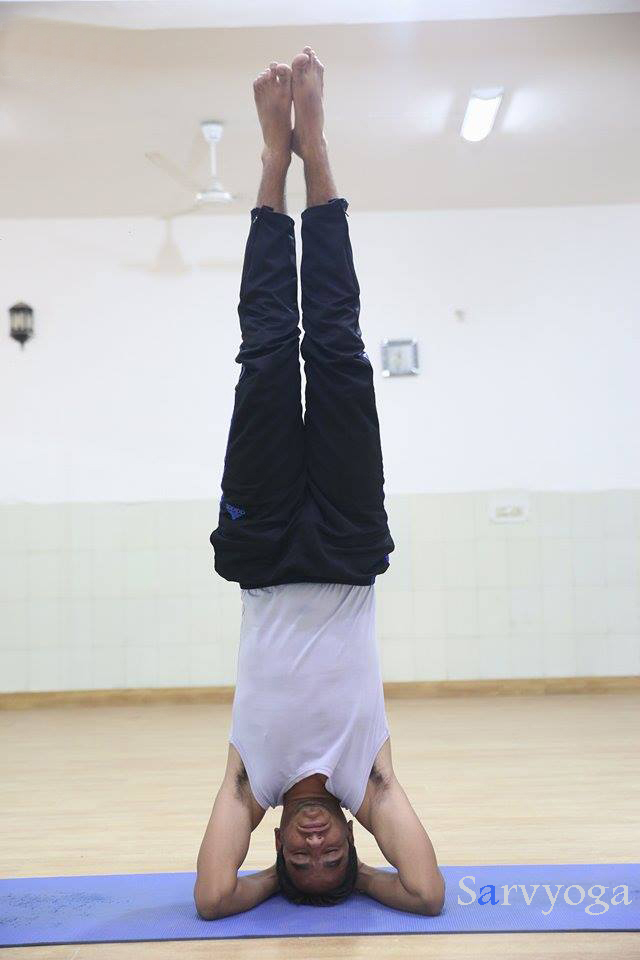 Name: – Shirshasana
Name: – Shirshasana
Sanskrit: – शीर्षासन
Meaning: – Headstand Pose
Pose Type: – Upside down
Shirshasana comes from the Sanskrit word “Shirsha” which means ‘Head’. There are so many variations in Shirshasana, in this, we describe Salamba Sirshasana (supported headstand pose) and this is a simple type of Shirshasana among all the variations of Shirshasana. In this, the body is totally inverted and held upright bolstered by the lower arms, and the crown of the head lies lightly on the floor.
Sirshasana is also known as the ‘king of all Asanas’ due to its various medical advantages, is an inverted stance. Its physiological impacts can be felt in the whole organism, yet all the more particularly at the level of the blood circulation, assimilation and endocrine system.
Navigator
Steps of Shirshasana (Headstand yoga pose)
- At first, go to the Child Pose (Balasana) from this pose snatch your elbows and interlock your fingers to shape an equilateral triangle. (It’s a base to the pose for your head support).
- Now bring down your crown of the head to the mat on the floor and the backside of your head is touching your hands. (Which you interlocked in the earlier step, support your head by your hands).
- Try to straighten your legs and slowly-slowly place your legs towards the direction of the head. Your back should be straight.
- Now bend your knees and keep your heels near to the butts.
- After that slowly- slowly raise your legs straight at the angle of 90 degrees.
- Breathe normally without any strain.
- Hold the position as much as you can.
- Now gently bend your knees and keep your heels near to the butts and come into the child pose.
(In the starting stage hold the position for a few moments, day by day increase the duration, if you feel uncomfortable leave the pose as soon as possible).
Benefits of Shirshasana
- Helpful in stress and increases concentration.
- It improves the blood flow to the Eyes.
- Gives strength to arms, shoulders and core muscles.
- Slows down the aging problems.
- Improves the blood circulation to the head and scalp.
- Improves the digestion and elimination process.
- Reduces fluid build-up in your feet, ankles, and legs.
- Increases the level of hemoglobin in the blood.
- Gives a gentle massage to the internal organs.
- It balances and stimulates the process of the endocrine glands, mainly the pituitary and pineal glands.
There are so many variations in Shirshasana and if you want to perform variations, first you have to master in the basic pose of Shirshasana (Salamba Shirshasana). Once you are master in basic then try these variations according to your comfort level.
Variations Headstand yoga pose
Salamba Shirshasana 2- Headstand Pose 2.
Salamba Sirshasana 3-headstand Pose 3.
Ek Pada Sirshasana – Single-Leg Headstand.
Baddha Hasta Shirshasana- Bound Hands Headstand.
Baddha Konasana Sirshasana- Bound Angle Pose Headstand.
Parivrttaikapada Shirshasana – Single-Leg Revolved Headstand.
Mukta Hasta Sirshasana – Free Hands Headstand.
Parshva Sirshasana – Side Headstand.
Parshvaikapada Sirshasana- Single-Leg Headstand.
Upavistha Konasana Shirshasana- Seated Angle Pose Headstand.
Urdhva Padmasana Sirshasana- Upward Lotus Pose Headstand.
IMPOTENT: –
This Asana should be avoided in the case of a neck injury, severe headache. During menstruation avoid this. People who are suffering from high B.P. problems, heart problems, brain injury, conjunctivitis, glaucoma, hernia, obesity, and hypertension are strictly advised not to perform this Asana. Consult an expert and doctor also before doing any yogic activities.
Headstand Yoga Pose (Sirsasana) FAQs
Yes, Sirsasana increases the flow of blood to your head and scalp, it helps to prevent hair fall, greying of hair and baldness. also, improve circulation and hence nourishment to the scalp improving hair growth. due to the oxygen-rich flow of blood, it also helps to improve the facial complexion.
it is very good if you can hold a Headstand yoga pose for 20 to 30 minutes. For beginners, they should start with 30 seconds to 1 minute and try to increase the time day by day.
People who suffer from neck ailments or scoliosis, People with heart conditions, vertigo, high blood pressure should avoid sirsasana. Children under the age of seven years should refrain from practicing headstands. Headstand is one of the riskiest yoga poses so only practice it under the guidance of an expert.
Yes, you can practice Sirsasana daily for 15 minutes. it will give you more benefits. Morning is the best time to practice yoga poses, you can also do in the evening also if you are not getting enough time in the morning.
At starting you can practice Headstand with the help of a wall or with the help of your friends and Yoga Teachers. and when you feel comfortable to make balance over your head try it without any wall, in an open area and try to hold accordingly. the practice is more important, only daily practice can help you maintain balancing.
Yes, Sirsasana is good for eyes because it increases the oxygen-rich blood flow towards the head which helps to activate all cells of our head including our eye cells.

